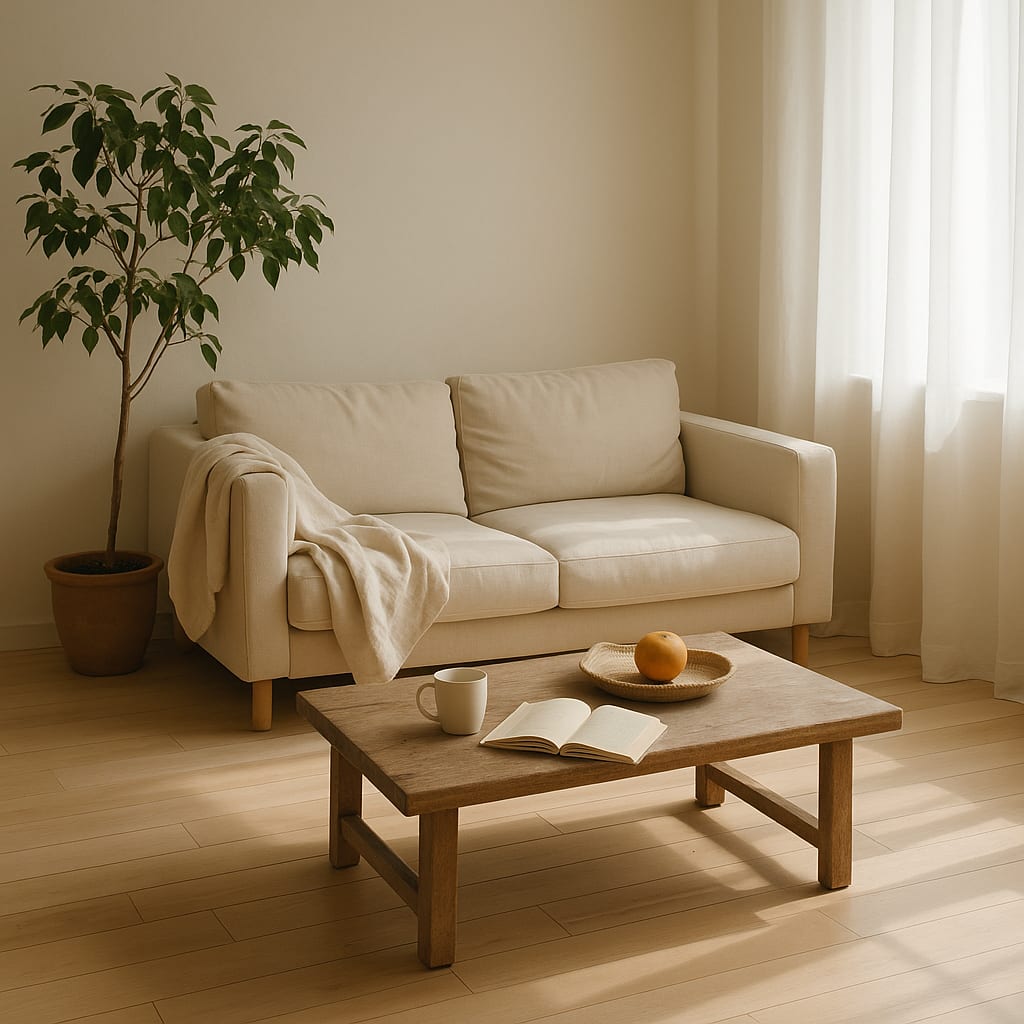Disconnecting from Chaos: Mindful Living Practices for a Minimalist Life

What is Mindful Living and Minimalism?
In today’s fast-paced society, the relentless barrage of notifications, advertisements, and endless to-do lists often leaves individuals feeling overwhelmed and disconnected. This is where mindful living and minimalism come into play, providing tools to navigate through this chaos. Mindful living encourages an awareness of thoughts and actions, while minimalism focuses on reducing excess to emphasize what truly enriches our lives.
Key Aspects of Mindful Living and Minimalism
The core tenets of these philosophies focus on three critical concepts: intentionality, simplification, and awareness.
- Intentionality: This involves making conscious decisions in every aspect of life, from the items you choose to keep in your home to the activities you engage in daily. For example, instead of mindlessly scrolling through social media, a mindful individual might decide to read a book that aligns with their interests or spend quality time with loved ones.
- Simplification: By reducing physical and mental clutter, individuals can create a serene environment that fosters clarity and focus. Techniques such as the KonMari Method encourage people to keep only those items that ‘spark joy.’ This not only refers to physical belongings but extends to relationships and commitments that bring happiness and fulfillment.
- Awareness: Practicing mindfulness involves being fully present in the moment, which can significantly enhance one’s appreciation for life’s simple pleasures. Activities such as mindful eating—savoring every bite of food—can transform an ordinary meal into an enriching experience, allowing individuals to connect with their senses more deeply.
Impact on Mental Well-being
The shift towards these practices can be transformative, particularly in the United States, where consumerism often dictates lifestyles. A study published by the American Psychological Association highlights that individuals who embrace minimalism report lower stress levels and greater mental clarity. This suggests that living with less can lead to living more fully. Additionally, by fostering a space for mindfulness, individuals can significantly enhance their emotional resilience as they learn to manage stress and anxiety more effectively.
As we dive deeper into the subsequent sections, we will explore concrete strategies for implementing these principles in daily life. Whether it’s by decluttering your living space or integrating mindful practices into your routine, there are many ways to start your journey toward a minimalist life. Prepare to uncover actionable steps that can lead to a more balanced, fulfilling existence, allowing you to reconnect with what truly matters and find lasting peace amidst the noise of modern life.
DISCOVER MORE: Click here to transform your space

Embracing the Shift: Practical Pathways to Mindful Minimalism
As the world continues to accelerate, many seek refuge in the harmonious blend of mindful living and minimalism. But what does it mean to truly embrace this lifestyle? It begins with recognizing the clutter—not just in our physical spaces but also in our minds and emotional landscapes. Simplifying our environment allows for the deployment of intentionality, which acts as a catalyst for deeper awareness and profound satisfaction. Here are some practical pathways to cultivate mindful living while embracing minimalism:
1. Declutter Your Space
The first step in fostering a minimalist lifestyle is to evaluate your living environment. Start by engaging in a systematic decluttering process. Examine each item you own and ask yourself a critical question: “Does this bring me joy?” Items that do not serve a meaningful purpose or evoke joy should be considered for donation or recycling. This process not only frees physical space but also clears mental clutter, providing a renewed sense of clarity.
2. Limit Digital Distractions
In a world dominated by screens, digital minimalism is as essential as tackling physical belongings. Evaluate your digital consumption: how many social media platforms do you engage with? How much time do you spend on your devices each day? To create a mindful connection, consider:
- Unsubscribing: Remove yourself from newsletters and notifications that do not add value to your life.
- Designate Tech-Free Zones: Establish areas in your home, like the dining room or bedroom, where technology is not allowed. This encourages more face-to-face connections and a greater awareness of your surroundings.
- Set Time Limits: Allocate specific time frames for browsing and stick to them to prevent overwhelming sensations of anxiety brought on by endless scrolling.
3. Integrate Mindfulness Practices
Mindfulness can easily be woven into daily routines. Practice meditation—set aside just ten minutes a day to focus on your breath. This can drastically improve your ability to transcend everyday chaos. Engaging in mindful activities such as yoga, journaling, or even walking can enhance your awareness of the present moment, fostering a deep connection with everything around you.
By incorporating these strategies, individuals can begin clearing the chaos from their lives, step by step. The transition into a mindful and minimalist lifestyle does not need to be overwhelming; rather, it can unfold gradually, allowing space for personal transformation. As we delve deeper into the following sections, we will uncover more transformative practices to cultivate balance and clarity, ultimately leading to a more intentional and fulfilling way of living.
| Advantages | Mindful Living Practices |
|---|---|
| Enhanced Focus | Mindfulness techniques, like meditation, promote clarity and concentration. |
| Reduced Stress | Practicing mindfulness leads to lower anxiety levels and improved emotional regulation. |
| Improved Well-being | Living minimally combined with mindfulness boosts overall happiness and satisfaction. |
| Clarity in Purpose | Identifying essential values helps in setting meaningful life goals. |
In the world of overwhelming distractions, the art of disconnecting from chaos becomes paramount. Mindful living practices such as meditation, journaling, and decluttering create an environment that fosters mental clarity and emotional resilience. These practices not only help in navigating daily stressors but also enhance one’s sense of purpose. Engaging consistently in mindfulness can lead to a profound transformation in how one perceives life’s challenges. It’s not merely about reducing clutter in one’s physical space but also about cleansing the mind of unnecessary turmoil. As we delve deeper into the benefits of embracing a minimalist lifestyle, it’s crucial to consider how intentional living can reshape our interactions with the world around us. The power of mindfulness in fostering awareness allows individuals to cultivate a sense of gratitude, positively impacting their mental health. By making deliberate choices to focus on what truly matters, we can reclaim our time, energy, and ultimately, our joy. This journey towards minimalism is not just about living with less; it is an invitation to live with intention, freeing ourselves from the chaos of modern life.
DISCOVER MORE: Click here to enhance your daily efficiency
Intentional Consumption: Nourishing the Mind and Body
In a society that champions consumerism, it’s essential to reevaluate how we approach every purchase. Intentional consumption, inherent to a minimalist lifestyle, requires engaging thoughtfully with what enters our lives. This goes beyond simply avoiding excessive belongings; it includes being mindful of the food we eat and the media we consume.
4. Mindful Eating
The journey to minimalism can begin at the dinner table. Mindful eating encourages a slower, more intentional approach to nourishing your body. Start by eliminating distractions during mealtime—turn off the TV and put down your phone. Allow yourself to savor each bite and appreciate the flavors, textures, and aromas of your food.
Consider implementing meal planning and prepping to minimize food waste and make the process even more intentional. The idea is not only to seek enjoyment in your meals but also to reinforce a deeper connection to where your food comes from. By choosing local, seasonal ingredients, you support sustainable farming practices, which align beautifully with the principles of minimalism—maintaining less while cherishing what is truly valuable.
5. Streamlining Social Commitments
Our social lives can quickly become overwhelming with numerous commitments stretching us thin. To cultivate a minimalist approach to relationships, focus on quality over quantity. Reflect on your current engagements: which gatherings feed your spirit and which drain your energy? Prioritize relationships that uplift you, and politely decline events that do not align with your values or well-being.
Consider engaging in more meaningful interactions, such as one-on-one coffee dates or small group gatherings. By choosing fewer but deeper connections, you not only respect your emotional bandwidth but also create a more nourishing social environment.
6. Establishing a Daily Routine
Routines can often feel restrictive, but when infused with mindfulness and minimalism, they become pathways to clarity and purpose. Assess your daily schedule and identify activities that contribute positively to your life versus those that simply fill time. A streamlined daily routine can provide structure while liberating you from unnecessary obligations.
- Create Morning Rituals: Design a morning routine that sets a positive tone for the day. Whether it’s a few moments of meditation, stretching, or journaling, beginning the day with intention can greatly enhance your overall well-being.
- Set a Nightly Wind-Down: As the day concludes, establish a calming bedtime routine that helps your mind transition into relaxation mode. This could include reading, meditation, or a technology-free hour to foster quality sleep.
Incorporating intentionality into various aspects of life—such as what we consume, how we connect with others, and how we manage our time—can significantly lessen chaos. By curating a lifestyle centered on the essentials, individuals can align themselves with their personal values, and engage more mindfully in the world around them. This transformative journey invites deeper understanding and a renewed appreciation for the simplicity that surrounds us.
DISCOVER MORE: Click here to learn how minimalism can enhance your time management
Embracing Minimalism for Inner Peace
As we navigate through the complexities of modern life, the principles of minimalism offer a refreshing antidote to chaos. By consciously selecting what we allow into our lives—whether it be our possessions, food, or social interactions—we cultivate an environment that promotes clarity and peace. Mindful living practices serve as critical anchors, enabling individuals to reconnect with their values and priorities amidst the noise of everyday distractions.
The journey toward a minimalist lifestyle is not merely about reducing physical clutter but extends to emotional and mental domains as well. Engaging in practices such as mindful eating encourages deeper appreciation for nourishment, while streamlining social commitments fosters connections that truly resonate with our authentic selves. Establishing routines that prioritize self-care offers individuals the stability needed to thrive in a fast-paced world.
As you reflect on your own life, consider which aspects might benefit from a touch of minimalism. Evaluate your consumption patterns, the quality of your relationships, and your daily activities. Each step taken toward intentional living can significantly reduce stress and enhance overall satisfaction. This path invites not only a new outlook on life but also a profound inner transformation—a chance to discover the richness of simplicity.
In a society that often equates happiness with accumulation, embracing minimalism as a philosophy paves the way to a more meaningful existence. So take the leap into mindful living, and begin to disconnect from chaos, welcoming serenity and fulfillment into your life.
Related posts:
Creating Calm Spaces: The Intersection of Minimalism, Mindful Living, and Personal Organization
Transforming the Daily Routine: Mindful Living as a Tool for Sustainable Minimalism
Mindful Living and the Attention Economy: Focusing on the Essentials in a World Full of Distractions
The Role of Meditation in Minimalist Practice: Cultivating an Organized and Mindful Life
Mindful Living and Connection with Nature: Redefining Our Living Spaces
Mindful Living and the Importance of Intention in Curating Our Possessions

Linda Carter is a writer and organization expert specializing in minimalism and personal organization. With extensive experience helping individuals create clutter-free, functional spaces and adopt mindful habits, Linda shares her knowledge on our platform. Her goal is to empower readers with practical advice and strategies to simplify their lives, stay organized, and achieve a sense of calm and balance in their daily routines.